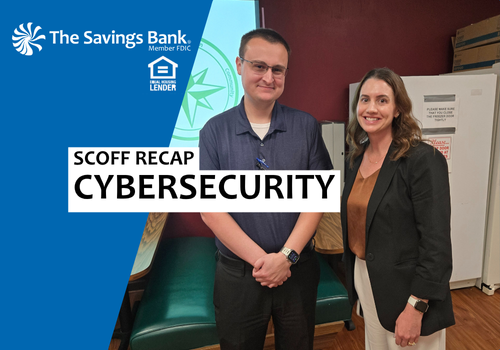SCOFF Recap: Cybersecurity
10/01/2025

SCOFF Recap: Cybersecurity
October is National Cybersecurity Awareness Month, and what better way to kick it off than to go through a recap of the most recent SCOFF event focused on cybersecurity? If you couldn’t make it, or would just like a refresher on the presentation, here are the high notes!
- Your information is out there. Over the last few decades, millions of Americans’ personal data has been leaked through breaches of major companies. These breaches often happen because criminals continue to find creative ways to hack into systems. Sometimes they can even gain access by hacking into an air conditioner unit or fish tank connected to the same network of devices that hold consumer data.
- The goal is to limit opportunities for criminals to gain access to you and your information. Password generators, multi-factor authentication, and more can help with this goal, but the main factor is you. These tools are only effective if you assist in keeping your information private. Here are some ways that were discussed to do so:
- Never use unsecured Wi-Fi networks out in public. Criminals can use Wi-Fi pineapples or other means to put out fake Wi-Fi networks. Once you connect to these networks, they can gain access to everything you do on your device. This means if you make an online purchase, the criminal will be able to see your credit card information. Best practice is to use your phone’s data.
- Never give out codes generated for multi-factor authentication. These codes are for you and ONLY you. No matter what anyone says, never give them the code. Multi-factor authentication is your last line of defense against criminals gaining access to your accounts.
- Never, ever click on unsolicited links. Whether this is a link in a text message, email, or scareware pop-up on your computer, never click on a link unless you have requested one from a trusted source. More than likely, these links are phishing attempts and can install malware or ransomware onto your device.
- Secure your devices. Never leave devices unattended and unlocked in public or where others may gain access to your device. Criminals have methods, like rubber ducky USB drives, that may be undetectable to you. Someone with one of these devices could copy your entire device and you would be none-the-wiser.
- Never re-use passwords or use simple passwords. Technology makes it so that criminals can run through millions of possible passwords almost instantly. You want to use complex passwords with at least 16 characters and a mix of uppercase, lowercase, numbers, and special characters to increase the chances they cannot generate your password quickly. Furthermore, never reuse passwords on multiple accounts, and be sure to change passwords every 90 days.
- BE ALERT! In public, examine credit card machines and ATMs for skimmers. Pay attention to any Wi-Fi networks your phone automatically connects to and make sure they are secure. Double check to make sure any websites you put your credit card information into are secure websites (noted by https://). Do not answer calls or texts from unknown numbers. If someone calls claiming to be from your bank, hang up and call your bank at a trusted number. Keep your devices close and locked. Examine any pop-up messages on your computer or phone, as most are scams.
While your bank and other vendors do what they can to ensure your information is safe and secure from criminals, half the battle lies with you. Through taking a few extra measures and remaining alert in your day-to-day tasks, you can ensure your information stays out of the hands of criminals.
Thank you to Austin Hohl for this informative and comprehensive presentation on cybersecurity! Keep an eye out on our social media pages for more SC

